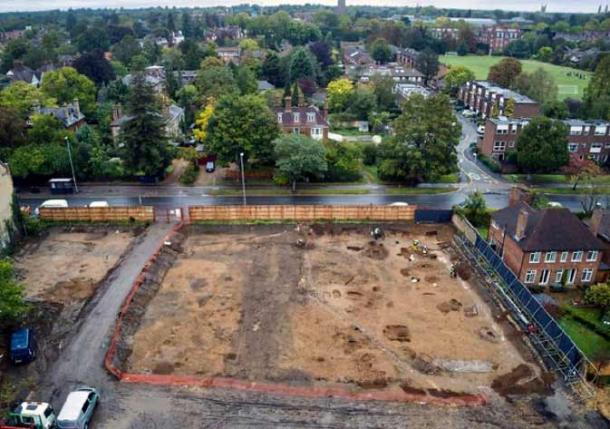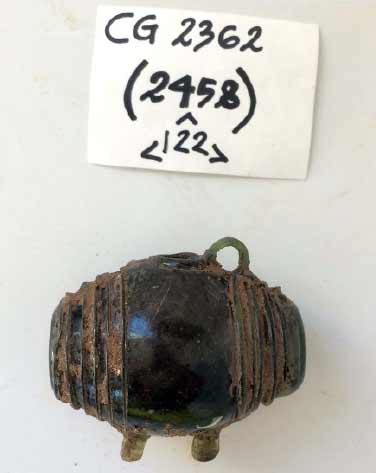New Anglo-Saxon Cemetery Finds Compared to Sutton Hoo Hoard
An Anglo-Saxon burial ground has been excavated on land destined to become University of Cambridge student accommodation. Archaeologists have called the hoard of grave artifacts one of archaeology's “most significant finds” since the in 1939 discovery of the Sutton Hoo treasure hoard.
Excavators working for England’s University of Cambridge were redeveloping the city’s Croft Gardens for new student accommodation when they discovered an Anglo-Saxon cemetery. Containing over 60 graves, strewn among the ancient Anglo-Saxon bodies the researchers discovered bronze brooches, bead necklaces, glass flasks and pottery, and weapons dating to between 450 and 600 AD. Furthermore, Iron Age structures and Roman period artifacts were also discovered at this site.
A Surprising Number Of Anglo-Saxon Burials
Dr Caroline Goodson is a senior Cambridge University lecturer and she said in a press release that the excavation of this cemetery provides “an outstanding opportunity” for the university archaeologists to explore very early medieval Britain. Furthermore, the researcher says each of the artifacts tells a different part of the story of how ancient Britons interacted with contemporary cultures on Continental Europe.

Image taken from arial drone footage of the site. (Dronescapes / Kings College)
A team of excavators from Albion Archaeology approached the site on Barton Road in Newnham (West Cambridge) in the understanding that evidence of an early medieval cemetery was reported in the nineteenth century. David Ingham, from Albion Archaeology, told the Daily Mail that while they always knew there was a chance of finding a cemetery, “we didn't expect to find as many graves as we did.” Ingham added that what “really surprised us” was how well the ancient items had survived beneath so many 20th century houses.
- Anglo-Saxon Settlement And Cemetery Complex Excavated In England
- Shadows of the Dead: Anglo-Saxon Burials are Spooky Sand Silhouettes
- New Sutton Hoo Movie Rights the Wrongs of Archaeological Snobbery
A Post-Roman Archaeological Treasure Hoard
Last summer a series of existing 20th century buildings at Croft Gardens were demolished when the university began developing new student accommodations. Dr Caroline Goodson said the construction project presented the university archaeologists with the perfect opportunity to “investigate the area archaeologically.” Goodson added that while burials from the Anglo-Saxon period are often found in small numbers, or with the bones barely surviving because of the soil's acidity, “this cemetery offers a real chance to fill some of the gaps in our knowledge about the people who lived in East Anglia after the Roman period had ended”.
The early Anglo-Saxon period burials, with their brooches, necklaces, pottery and weapons, is already revealing new information about dress, burial habits, and health and disease of the time period.
According to Professor Goodson, new methods of analysis are being applied to the discoveries made at the site in the hope of finding fresh information “about migration and family relationships across medieval Britain and Northern Europe.”
Professor Michael Proctor, Provost of King's College Cambridge told the press “These finds are tremendously exciting for King’s,” and that he will appoint a four-year research fellow to continue the work.

A Roman glass vessel was one of the many items unearthed at the site. (Albion Archaeology)
Cambridge Is On A Roll
It could be said Cambridge is on something of an ‘archaeological roll.’ Only last week I wrote a news article for Ancient Origins about a new paper that looks at the “skeletal trauma" discovered on hundreds of people who lived in medieval Cambridge between the 10th and 14th century. This study revealed varying levels of “physical hardship across lower classes,” demonstrating that while the traditionally posh city hosts the second oldest university in the English-speaking world, for the majority of folk, life was hard, and dangerous if not downright awful.
What is refreshing in all these new studies coming out of Cambridge is that the archaeologists are clearly not as interested in the royal and noble history of the city, as they are in the people’s history. The excavation of this Anglo-Saxon cemetery, and the discoveries presented in the last paper, mean that Cambridge will very soon have new insights into the day to day lives of folk living in the city between the 6th and 14th centuries.
Top image: Human remains at the Anglo- Saxon Croft Gardens site, Cambridge. Source: Albion Archaeology
By Ashley Cowie



















